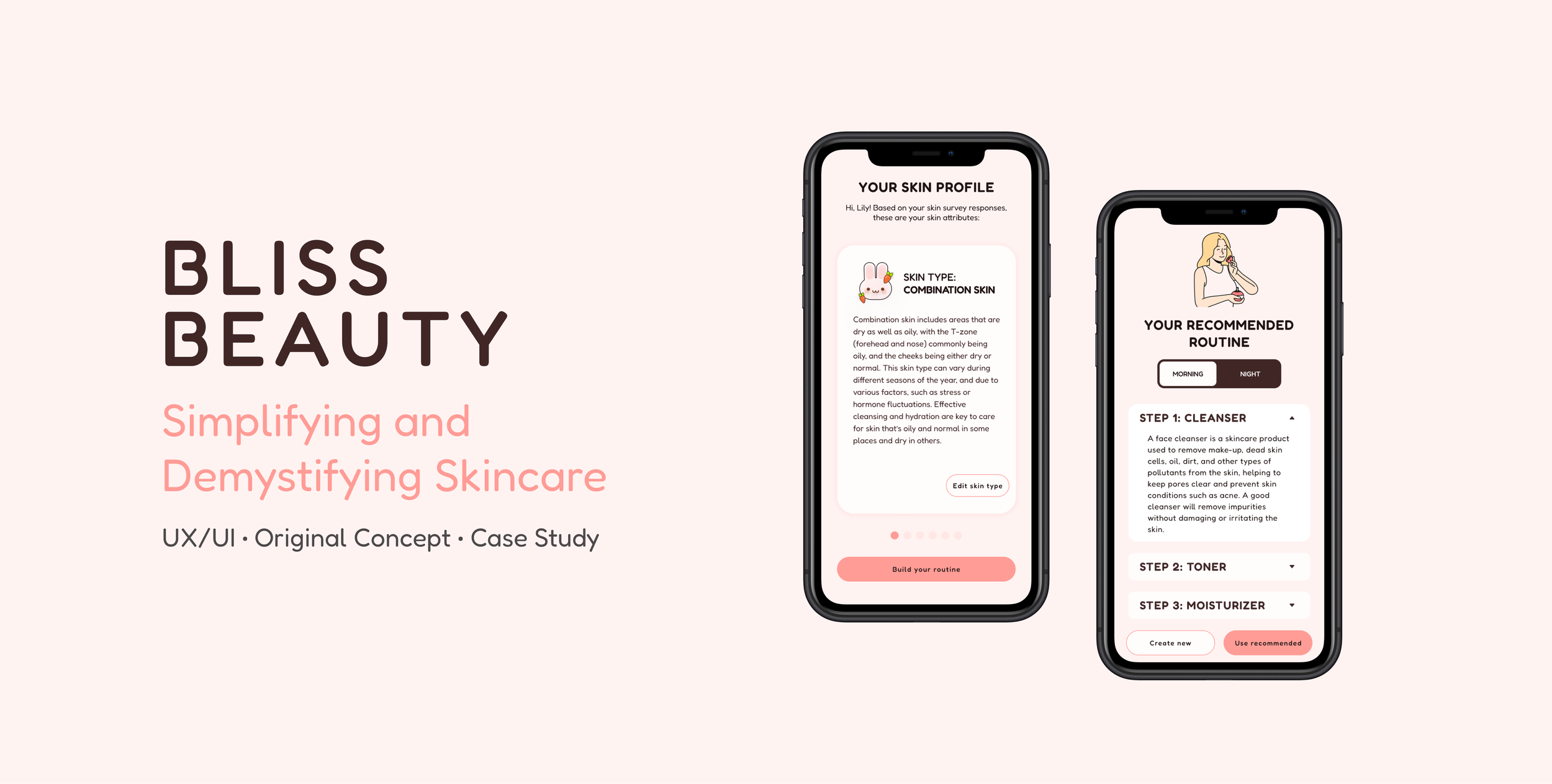
BLISS BEAUTY
Simplifying and Demystifying Skincare
People are increasingly concerned with the wellbeing of their skin health, as our self-confidence and even mental health can hinge on how comfortable we feel in our skin. However, many people struggle with finding the right products to care for their skin type or skin concern.
What if we could leverage technology to demystify and simplify the process of discovering effective skincare?
ROLES & RESPONSIBILITIES: Research, UX/UI
PROJECT CONTEXT: Contracted Project
DURATION: 3 Months (Spring 2023)
TOOLS USED: Figma, Mural, Flowmapp, Zoom, Octopus, POP by marvel
PROBLEM
The skincare market is overwhelming and confusing.
Many people struggle with finding the right products to care for their skin type or skin concern, but the skincare market has grown to become overwhelming and confusing. How can we utilize technology to make it easier for people to discover effective products for their skin?
SOLUTION
Increase accessibility and simplify information about skincare.
An interactive application that acts as a one-stop shop for skincare needs. The application makes information about their own skin more accessible and convenient to allow everyone take control of their own skin care as well as establishing a platform for people to access advice from skincare professionals or peers.
SECONDARY RESEARCH
There is a need for more ingredient education.
60 percent of consumers report they feel uninformed about proper skin cleansing methods.
65 percent have no idea what ingredients to look for when purchasing a facial cleanser, and 63 percent don't understand the purpose of those ingredients.
COMPETITIVE RESEARCH
USER INTERVIEWS
I conducted quantitative surveys and qualitative interviews to identify my users’ needs and struggles. The surveys were completed via a Google form. There were a total of 68 participants, consisting of individuals from ages 16-30. The interviews were completed in 30-minute intervals and included two students, two young adults, and one middle-aged adult.
User Interview Questions:
Why is it difficult for people to find skincare that works for them?
How are people most commonly discovering new skincare products for their needs?
Do people know about their skin needs and do they understand the ingredients that can target their skin needs?
What influences people the most to purchase/try a skincare product for the first time?
MAIN INSIGHTS
I synthesized my findings using an affinity map and discovered the following main themes:
ACCESSIBILITY AND CONVENIENCE
People prefer social media platforms such as Tiktok for skincare recommendations because they want quick information that is easily accessible, convenient, and digestible.
CHOICE OVERLOAD
Participants noted that they often purchase what is popular or listen to influencers because there are too many products to choose from and they don’t know how to tell what works for them.
LACK OF INGREDIENT EDUCATION
People don’t know about the ingredients in their skincare because the ingredient names are too complicated and they feel the companies are not transparent enough about what the product does.
SOCIAL ACCEPTANCE
People don’t like to waste time or money on skincare but do so because they want to heal their skin to feel more confident in their own skin or to prevent skin diseases so they are not judged by others around them. People want to feel accepted.
USER PERSONAS
Based on my findings, I created two personas for consumers for both ends of the spectrum on skincare knowledge and concerns: someone who needs more guidance and someone who needs a tool to streamline their research.
SOLUTION IDEATION
I mapped out the user journey for the following tasks:
Set up a user profile
Create a skincare routine
Talk to a dermatologist
Join a skincare community
Search for new products
View skincare guides*
Leave a review for a purchased product*
*This feature mapped here is not included in the final prototype as part of the Minimum Viable Product (MVP).USABILITY TESTING & IMPROVEMENTS
There were 3 major improvements in my design after 2 rounds of usability testing with 5 participants each round to gather first impressions and potential usability issues.
FINAL MOCKUPS & PROTOTYPE
THE STYLE GUIDE
CONCLUSION
Things I learned and what I would do next time…
There are no mistakes or failures, only lessons.
As this is my first UX project, I was learning the UX process as I progressed on my project and it brought a lot of challenges due to a lack of foresight. I struggled a lot with thinking ahead and really had to take everything step by step. Throughout this experience, I’m glad to have had the support of my mentor and peers for their guidance and feedback. This project was invaluable for showing me that collaboration is a core element of the design process and that it is important to have some framework as a guide as you design.
Continually test and iterate.
If I had more time, I would continue to conduct usability testing and iterate until every aspect of the prototype is designed with intention and backed by research. I originally had a ton of ideas, trying to solve a billion problems, and it was through testing that I was able to narrow down on what was really important and served the core needs of the users.
Thank you for reading! 📖
If you have any questions for me or about my work, feel free to reach out at lilyfn19@gmail.com.










